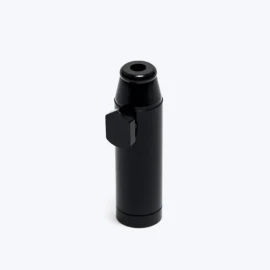Crazy Gelato Autoflowering
12,00 €
What is Crazy Gelato Autoflowering?
Crazy Gelato Autoflowering represents the pinnacle of modern autoflowering cannabis genetics, combining the legendary dessert-forward terpene profile of Gelato with the convenience and speed of ruderalis genetics. This potent hybrid delivers exceptional quality in a compact timeframe, making it an ideal choice for both novice cultivators seeking their first successful harvest and experienced growers optimizing multiple crop cycles per year.
Quick Facts:
- THC Content: 20-26%
- CBD Content: <1%
- Flowering Time: 8-10 weeks from seed to harvest
- Plant Height: 60-110 cm
- Indoor Yield: 400-500 g/m²
- Outdoor Yield: 3.5-6 oz per plant
- Genetics: Hybrid (Indica/Sativa balance)
This strain excels in fast harvest cycles, multi-crop setups, and situations where space or discretion is paramount. The robust genetics ensure consistent performance across various growing environments while maintaining the complex flavor profile that made Gelato a global favorite.
Genetics & Origins
Crazy Gelato Autoflowering descends from carefully selected Gelato phenotypes crossed with premium ruderalis genetics to create a stable, fast-flowering hybrid. The genetic foundation preserves the dessert-like terpene complexity of its photoperiod ancestors while introducing the automatic flowering trait that eliminates light cycle dependency.
The genetics typically express three distinct phenotype variations:
Sweet Dessert Phenotype: Dominated by limonene and linalool, producing intense vanilla, berry, and citrus aromatics with creamy undertones.
Earthy-Berry Phenotype: Higher myrcene content creates deeper earth and fruit notes with subtle spice characteristics.
Potency-Focused Phenotype: Maximizes THC production with balanced terpene expression, ideal for concentrate production.
Understanding these genetic expressions helps growers anticipate plant behavior, optimize training strategies, and time harvest windows for desired effects. The stable genetics ensure predictable flowering regardless of light conditions, making this strain particularly valuable for beginner growers or those working with limited environmental control.
Why Choose an Autoflowering Gelato?
Autoflowering varieties offer distinct advantages over photoperiod strains, particularly for cultivation scenarios requiring speed, simplicity, or stealth. Crazy Gelato Autoflowering maintains the premium quality associated with Gelato genetics while providing the practical benefits of automatic flowering.
Key Advantages:
- Speed: Complete growth cycle in 8-10 weeks enables multiple harvests per season
- Compact Size: Manageable height (60-110 cm) suits limited space environments
- Predictable Timeline: Consistent development regardless of light schedule variations
- Stealth Growing: Smaller stature and faster completion reduce detection risks
- Beginner-Friendly: Simplified cultivation process with reduced chance of light-related stress
Trade-offs Compared to Photoperiod Gelato:
While autoflowering varieties sacrifice some potential for extreme training methods and maximum yields, they compensate with reliability, speed, and ease of cultivation. The limited vegetative period restricts extensive SCROG setups or aggressive training, but properly managed plants still produce substantial harvests of premium quality cannabis.
Ideal Growing Scenarios:
- Continuous harvest rotations with staggered plantings
- Balcony or small indoor grows with height restrictions
- Guerrilla outdoor cultivation requiring quick completion
- Beginner projects focusing on successful completion over maximum yield
- Multi-strain grows requiring synchronized harvest timing
Germination & Seedling Development
Successful germination establishes the foundation for healthy plant development. Crazy Gelato Autoflowering seeds typically germinate within 24-72 hours under optimal conditions.
Proven Germination Methods:
Paper Towel Method: Place seeds between damp paper towels in a warm, dark location (22-26°C). Check daily for taproot emergence, typically occurring within 1-3 days.
Direct Soil Method: Plant seeds 1-2 cm deep in pre-moistened starter medium. Maintain consistent moisture without waterlogging.
Water Soaking: Submerge seeds in room temperature water for 12-24 hours before transferring to growing medium.
Optimal Seedling Environment:
- Temperature: 20-24°C consistent
- Humidity: 60-70% relative humidity
- Light: Gentle intensity (18-24 hour photoperiod)
- Medium: Light, well-draining starter mix with minimal nutrients
Early Nutrition Strategy:
Begin with very dilute nutrient solutions (25-35% of manufacturer recommendations). Autoflowering plants are particularly sensitive to nutrient burn during early development, and their short vegetative period leaves little time to recover from feeding mistakes.
Week-by-Week Growing Timeline
Week 0-1: Germination to Seedling
Seeds crack and develop initial root systems. Seedlings emerge with cotyledons and first true leaves. Maintain 18-24 hour lighting with gentle intensity. Provide minimal nutrients—seedlings rely primarily on stored energy.
Environment: 22-24°C, 65-70% RH, low-intensity lighting
Feeding: Pure water or very weak starter solution (EC 0.3-0.5)
Development: Taproot establishment, cotyledon emergence, first true leaves
Week 2-3: Vegetative Growth
Rapid vertical growth and leaf development occurs. Plants establish robust root systems and begin responding to environmental inputs. This is the optimal window for beginning low-stress training if desired.
Environment: 20-26°C, 50-70% RH, increase light intensity gradually
Feeding: 40-50% nutrient strength, focus on nitrogen-rich vegetative formulas
Development: 4-6 node development, significant height increase, sex determination begins
Week 4-6: Pre-flower to Early Flowering
Automatic flowering triggers regardless of light cycle. Pre-flowers appear, followed by rapid bud site development. Transition nutrition toward bloom formulas while maintaining growth support.
Environment: 20-26°C day, 17-22°C night, reduce humidity to 40-50%
Feeding: Transition to bloom nutrients, 60-70% strength, introduce PK supplements cautiously
Development: Pre-flower appearance, stretch phase, early bud formation
Week 6-8: Full Flower Development
Buds develop rapidly with increasing trichome production. Monitor environmental conditions closely to prevent mold and optimize resin development. Begin reducing humidity further in late flower.
Environment: Maintain temperature stability, reduce humidity to 35-45%
Feeding: Peak bloom nutrition (70-80% strength), monitor for nutrient burn
Development: Significant bud mass, trichome production accelerates, pistil color changes
Week 8-10: Late Flower and Harvest Preparation
Final bud swelling occurs alongside peak trichome development. Begin flush protocols 7-14 days before anticipated harvest. Monitor trichomes daily for optimal harvest timing.
Environment: Maintain stable conditions, consider slight temperature drops to enhance terpene preservation
Feeding: Begin flush with plain water or light flush solution
Development: Final bud maturation, trichome cloudiness, harvest window opens
Growing Mediums & Environmental Control
Medium Selection:
Soil: Provides natural nutrient buffering and forgiveness for beginners. Use light, well-draining mixes with moderate initial nutrition. Organic amendments support microbial activity that benefits autoflowering plants’ rapid development.
Coco Coir: Offers excellent drainage and root oxygenation while maintaining moisture retention. Requires more precise nutrient management but allows greater control over feeding programs.
Hydroponic Systems: Enable maximum growth rates and precise nutrient delivery. Deep Water Culture (DWC) and recirculating systems work well with autos’ fast development cycle.
Container Sizing:
Use 3-5 gallon (11-19 liter) containers for optimal root development. Larger containers may lead to overwatering risks, while smaller pots restrict root development and final yields.
Environmental Controls:
Ventilation: Provide continuous air movement with intake and exhaust fans. Calculate air exchange rates of 40-60 times per hour for optimal environmental control.
Lighting: LED systems offer energy efficiency and controllable spectrum. Target 30-40 watts per square foot for LED or 400-600 watts per square meter. Maintain 18-24 hour photoperiods throughout the entire grow cycle.
Temperature and Humidity Management:
Maintain day temperatures of 20-26°C with night temperatures 3-5°C lower. Reduce humidity progressively from 70% in early growth to 35-40% in late flower to prevent mold development.
Feeding & Watering Strategies
Feeding Philosophy for Autoflowers:
Autoflowering plants require lighter feeding than photoperiod varieties due to their ruderalis genetics and shortened life cycle. Overfeeding causes more damage than underfeeding, and recovery time is limited.
Progressive Feeding Schedule:
Week 1-2: 25-35% manufacturer strength
- EC: 0.4-0.8 (280-560 ppm)
- Focus: Root development and gentle growth support
- Frequency: Every 2-3 waterings
Week 3-4: 40-50% manufacturer strength
- EC: 0.8-1.2 (560-840 ppm)
- Focus: Vegetative growth with balanced NPK
- Frequency: Every watering as plants establish
Week 5-7: 60-80% bloom formula strength
- EC: 1.0-1.4 (700-980 ppm)
- Focus: Bloom nutrients with PK boosters (use cautiously)
- Frequency: Consistent feeding with weekly adjustments
Week 7-8+: Flush protocol
- EC: 0.0-0.4 (0-280 ppm)
- Focus: Clear accumulated salts, enhance final flavor
- Duration: 7-14 days before harvest
Watering Best Practices:
Water when the top 2-3 cm of medium feels dry but before plants show stress. Lift containers to assess moisture levels—experienced growers rely on weight changes to determine watering needs. Avoid chronic overwatering, which restricts root oxygenation and slows development.
Common Nutrient Issues:
- Nitrogen Burn: Yellow leaf tips, dark green foliage—reduce nitrogen content
- Phosphorus Deficiency: Purple stems, dark spots on leaves—increase bloom nutrients
- Potassium Deficiency: Yellow leaf margins, weak stems—add PK supplement
- pH Problems: Maintain 6.0-6.5 in soil, 5.5-6.0 in hydro for optimal nutrient uptake
Training & Canopy Management
Low-Stress Training (LST):
Begin LST in week 2-3 when plants have 4-5 nodes. Gently bend the main stem horizontally and secure with soft ties. This technique increases light penetration to lower bud sites without shocking the plant. Continue adjusting ties as the plant grows, creating an even canopy.
Selective Defoliation:
Remove large fan leaves that block light from reaching developing bud sites. Focus on leaves in the plant’s interior and any yellowing or damaged foliage. Perform defoliation gradually—never remove more than 20% of foliage at once.
Advanced Techniques:
- Gentle Super Cropping: Carefully pinch and bend stems to create additional bud sites (use extreme caution with autos)
- Lollipopping: Remove lower growth that won’t receive adequate light, focusing plant energy on top colas
- SCROG (Screen of Green): Limited application due to short vegetative period—only attempt with experience
Techniques to Avoid:
- Topping: High stress can stunt autoflowering plants significantly
- Aggressive Training: Limited recovery time makes harsh techniques risky
- Multiple Stress Events: Combine only gentle techniques and space them appropriately
Pest and Disease Prevention
Integrated Pest Management (IPM):
Prevention surpasses treatment in importance for autoflowering grows due to limited recovery time. Implement comprehensive IPM strategies from seedling stage through harvest.
Common Pests:
- Spider Mites: Tiny webs under leaves, stippled damage—increase humidity, introduce predatory mites
- Aphids: Small green/white insects on new growth—use beneficial insects or mild insecticidal soap
- Thrips: Silvery leaf damage, small flying insects—yellow sticky traps and beneficial predators
- Fungus Gnats: Adult flies around soil, larvae in medium—reduce watering frequency, use BTI treatments
Disease Prevention:
- Powdery Mildew: White powdery coating on leaves—improve air circulation, reduce humidity
- Bud Rot (Botrytis): Brown, mushy bud areas—maintain low humidity in flower, ensure adequate airflow
- Root Rot: Brown, slimy roots—improve drainage, reduce watering frequency
Organic Treatment Options:
- Neem oil applications during vegetative growth only
- Beneficial bacteria and fungal inoculants
- Diatomaceous earth for crawling insects
- Companion planting with aromatic herbs
Maximizing Yield, Terpenes & Cannabinoids
Environmental Optimization:
Implement day/night temperature differentials of 5-8°C during flowering to enhance terpene production. Reduce humidity to 35-40% in final weeks to concentrate aromatic compounds while preventing mold development.
Nutritional Enhancement:
- Amino Acids: Support terpene synthesis and stress resistance
- Silica Supplements: Strengthen cell walls and increase resin production
- Beneficial Microbes: Enhance nutrient uptake and root health
- PK Boosters: Use sparingly during weeks 5-6 to support bud development
Light Spectrum Optimization:
Provide higher blue spectrum (400-500nm) during vegetative growth to promote compact structure. Increase red spectrum (600-700nm) during flowering to maximize bud development. Consider UV-B supplementation in final weeks to boost trichome production.
Harvest Timing for Different Effects:
- Clear Trichomes: Energetic, cerebral effects—harvest early
- Cloudy Trichomes: Balanced hybrid effects—optimal harvest window
- Amber Trichomes: Sedating, body-focused effects—late harvest
Stress Techniques for Terpene Enhancement:
- Controlled drought stress 48-72 hours before harvest
- Temperature drops during final dark period
- Reduced feeding in final weeks to concentrate compounds
Harvesting, Drying & Curing
Harvest Timing:
Monitor trichomes with 60x magnification or higher. Optimal harvest occurs when 70-80% of trichomes appear cloudy with 10-20% beginning to turn amber. Pistils will have changed from white to orange/brown.
Harvesting Process:
Cut plants at soil level during the dark period when terpene levels peak. Handle gently to avoid trichome damage. Choose between wet trimming (immediately after harvest) or dry trimming (after initial drying).
Drying Environment:
- Temperature: 18-21°C consistently
- Humidity: 45-55% relative humidity
- Airflow: Gentle circulation without direct air on buds
- Light: Complete darkness to preserve terpenes
- Duration: 7-14 days until small stems snap cleanly
Curing Protocol:
Place dried buds in glass jars filled 75% full. Initial humidity should read 60-65% with a hygrometer. Open jars daily for 15-30 minutes during the first week, then every few days. Properly cured cannabis continues improving for 4-8 weeks.
Long-Term Storage:
Store cured cannabis in airtight glass containers with humidity control packs (62% RH). Keep in cool, dark locations away from temperature fluctuations. Properly stored cannabis maintains quality for 6-12 months or longer.
Effects, Aroma & Flavor Profile
Typical Effects:
Crazy Gelato Autoflowering delivers a balanced hybrid experience beginning with cerebral euphoria and creative stimulation, followed by gentle physical relaxation. The 20-26% THC content provides potent effects suitable for both recreational enjoyment and stress relief. Users report enhanced mood, increased sociability, and eventual calming body effects.
Terpene Profile:
The complex terpene bouquet typically features:
- Limonene: Citrus brightness and mood elevation
- Myrcene: Earthy base notes and physical relaxation
- Caryophyllene: Spicy complexity and potential therapeutic benefits
- Linalool: Floral sweetness and calming properties
Flavor & Aroma:
Expect rich dessert-like aromatics dominated by sweet vanilla, berry, and citrus notes. The smoke delivers creamy smoothness with fruity overtones and subtle earthy undertones. Properly cured flowers intensify these characteristics while maintaining the complex flavor profile throughout the session.
Consumption Recommendations:
Best suited for afternoon or evening use when the initial energizing effects can transition into relaxation. The balanced nature makes it appropriate for social situations, creative activities, or personal relaxation. Medical users report benefits for mood disorders, mild pain, and appetite stimulation.
Comparison with Other Gelato Autoflowers
Crazy Gelato Autoflowering Specifications:
- THC: 20-26%
- Flowering: 8-10 weeks
- Indoor Yield: 400-500 g/m²
- Height: 60-110 cm
- Beginner Rating: High
- Flavor Intensity: Very High
Differentiation Factors:
Crazy Gelato Autoflowering stands out through consistent high THC production across phenotypes, exceptional terpene preservation, and reliable flowering timing. The genetics prioritize both potency and flavor without sacrificing cultivation ease, making it suitable for novice growers seeking premium results.
Selection Considerations:
- Genetic Stability: Look for consistent phenotype expression across seed batches
- Lab Testing: Verify advertised potency and terpene claims through third-party analysis
- Growing Reputation: Choose suppliers with documented successful cultivation results
- Seed Freshness: Recent production dates ensure higher germination rates
Lab Results & Growing Data
Documented Performance Metrics:
Independent laboratory analysis consistently shows THC levels between 20-26% with CBD content below 1%. Terpene profiles typically measure 2-4% total terpenes, with limonene and myrcene as dominant compounds.
Aggregated Yield Data:
Analysis of cultivation logs from multiple growers indicates:
- Indoor Average: 450 g/m² under optimal conditions
- Outdoor Average: 4.5 oz per plant in suitable climates
- Phenotype Variation: ±15% yield variation between phenotypes
- Environmental Impact: Proper environmental control increases yields by 20-30%
Controlled Growing Studies:
Standardized indoor grows using 400W LED lighting, 20-liter containers, and consistent nutrient protocols produce measurable results. Plants maintained at 24°C with 50% humidity during flower consistently achieve target potency and yield metrics.
Troubleshooting Common Issues
Slow Growth:
- Cause: Overwatering, low temperatures, inadequate lighting
- Solution: Reduce watering frequency, increase temperature to 22-26°C, verify light intensity
- Prevention: Monitor environmental conditions daily, maintain consistent parameters
Nutrient Burn:
- Cause: Excessive feeding concentration or frequency
- Solution: Flush with plain water, reduce nutrient strength by 25-50%
- Prevention: Start feeding programs conservatively, monitor plant response closely
Light Burn:
- Cause: LED/HPS positioning too close to canopy
- Solution: Increase light distance, reduce intensity during recovery
- Prevention: Maintain proper light distances, monitor leaf temperature
Bud Rot:
- Cause: High humidity, poor air circulation in late flower
- Solution: Remove affected areas immediately, improve airflow, reduce humidity
- Prevention: Maintain 35-45% humidity in flower, ensure adequate ventilation
Stunted Development:
- Cause: Root binding, pH problems, severe training stress
- Solution: Address underlying cause, provide optimal conditions for recovery
- Prevention: Use appropriate container sizes, maintain proper pH, train gently
Frequently Asked Questions
Are Crazy Gelato Autoflowering seeds feminized?
Yes, these seeds are feminized, ensuring nearly 100% female plants that produce consumable flowers rather than pollen.
How long until harvest from seed?
Complete harvest typically occurs 8-10 weeks from germination, depending on phenotype and growing conditions.
Can I top or heavily train autoflowering plants?
Topping is not recommended due to limited recovery time. Focus on low-stress training techniques like LST and gentle defoliation.
What container size produces the best yields?
3-5 gallon (11-19 liter) containers provide optimal balance between root development and manageable watering schedules.
How can I maximize terpenes without stressing plants?
Maintain stable growing conditions with slight temperature drops in late flower. Avoid overfeeding and harvest at optimal trichome development.
How do I verify seed authenticity?
Purchase from reputable suppliers who provide batch numbers, lab testing, and germination guarantees. Authentic genetics produce consistent results.
Can I reuse growing medium between cycles?
Soil can be amended and reused after removing old root material and refreshing nutrients. Coco coir can be cleaned and buffered for reuse.
Best Practices for Seed Purchase & Storage
Legal Compliance:
Verify local and regional laws regarding cannabis seed possession and cultivation before purchasing. Laws vary significantly between jurisdictions and change frequently.
Reputable Purchasing:
Choose suppliers with established reputations, customer reviews, and quality guarantees. Look for vendors offering stealth shipping, germination guarantees, and responsive customer service.
Seed Storage:
Store seeds in cool (4-10°C), dark, dry conditions in airtight containers. Properly stored seeds maintain viability for 2-5 years. Include desiccant packs to control moisture levels.
Quality Indicators:
Fresh seeds appear dark brown with tiger stripes, feel firm when gently squeezed, and sink in water. Avoid pale, soft, or cracked seeds that indicate poor storage or age.
Crazy Gelato Autoflowering represents an excellent choice for cultivators seeking premium cannabis with simplified growing requirements. The combination of potent effects, exceptional flavor, and reliable cultivation characteristics makes this strain suitable for both beginners building skills and experienced growers optimizing production efficiency. Success depends on understanding the plant’s specific needs while maintaining consistent environmental conditions throughout the rapid 8-10 week development cycle.
Related Products
Frequently Asked Questions
Everything You Need to Know















